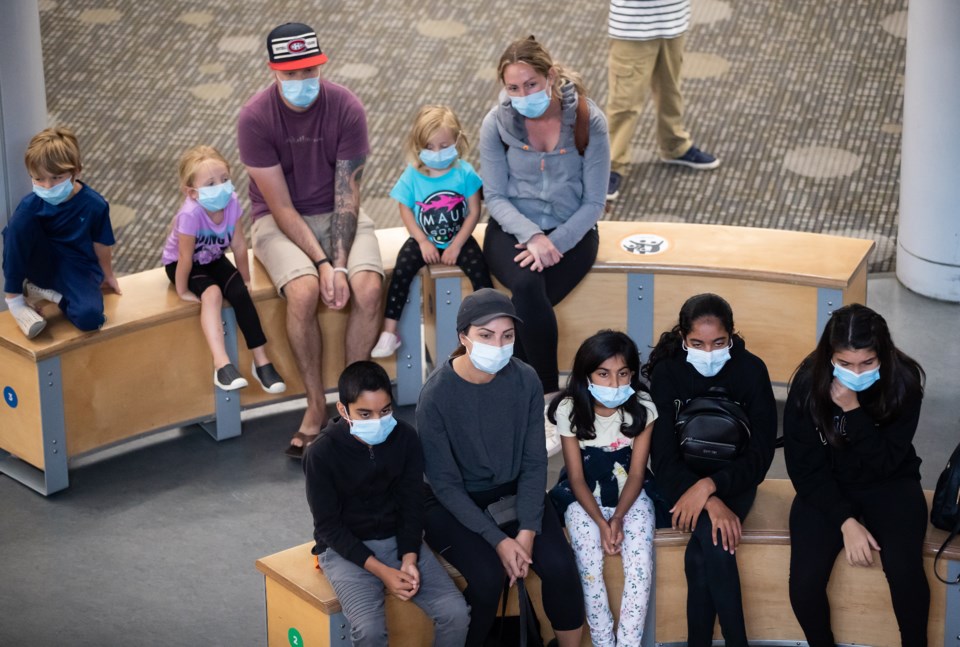When Meghan Ewing travels abroad, she focuses on peoples' faces to decipher what they're saying in languages she doesn't understand.
Studying facial expressions is a common practise among anyone dealing with a linguistic barrier, says Ewing, an ESL teacher in Guelph, Ont.
And children do it all the time.
With face coverings mandated for Ontario teachers in classroom settings as a safety precaution amid the COVID-19 pandemic, Ewing worries students learning English for the first time will miss out on an important visual component.
"Your face expresses so much of your message," Ewing said. "And whether the (student) is older or younger, if they're learning the language for the first time, they're coming from that same starting point and they need to have those non-verbal cues to understand the message."
Face coverings, mandatory in most indoor public places across the province, can help limit the spread of COVID-19 by slowing down respiratory droplets that spew out from the wearer's mouth when they cough, talk or breathe.
Ontario students from grades 4 to 12 will be wearing them in the classroom when school begins next month, and educators, regardless of what grade they're teaching, will need to wear them, too.
Masking mandates vary across the country.
B.C. teachers, staff and students are not required to wear face coverings in classrooms, but they are recommended for adults and older students when they are unable to physically distance. Alberta, meanwhile, says masks will be mandatory in "some school settings" and Quebec's teachers, staff and students are required to wear them in common areas of school buildings, such as hallways, but not classrooms.
While most Ontario teachers would agree that safety is the priority, some are concerned about how face coverings will impact the learning environment. And they worry about students who are already facing language barriers being disproportionately affected.
Ewing says her ESL students watch her "like a hawk," observing how her mouth moves when making certain sounds.
"You need to be able to see what the lips are doing," she said. "That's just the way languages work."
Rachel Heydon, an associate professor in the Faculty of Education at Western University, says any young student in the language development phase of life will miss out on that non-verbal communication when teachers wear face masks.
But those who are "culturally and linguistically diverse" will have extra challenges.
"There are vulnerabilities there," Heydon said. "Just like young children who are developing speech, they are also learning how to make new sounds and you need that modeling, you need that demonstration of how you do that.
"And without that visual feedback, that will be very challenging."
Students with hearing impairments will face disadvantages in not being able to read lips or see facial expression, says Dr. Todd Cunningham, a child psychology expert at the University of Toronto.
And that can be further exacerbated if a teacher's voice is distorted through the fabric.
"Those children often look to the mouth to be able to acquire more information about what is coming out," Cunningham said. "And what's not known is will the cloth masks impact the acoustic code? Will it dampen the sound or muffle some of the sounds within our language?"
Face masks can make it difficult for teachers to provide positive or negative feedback, either with a smile or a frown, Cunningham said, and tone can be misunderstood if facial expressions are removed.
Heydon also worries that masks can make it harder for younger children, who are learning to read emotions, to form connections to their teachers.
"That has a huge bearing on children's engagement, their motivation, their willingness to learn and what they will take on," she said. "Children learn from the people who they trust ... and (wearing a mask) makes it that much more difficult to form those kinds of relationships."
Cunningham doesn't think masks will have too great an impact on students' ability to form emotional connections with their teachers, however, saying educators will find ways to build trust with students.
Other forms of body language become more important, he says, and teachers will be creative in making up for the non-verbal communication they're losing when wearing face masks.
"Are we going to have a whole bunch of kids who have language impairments or comprehension impairments? No, I don't think so," Cunningham said. "Teachers are still going to be engaging in all kinds of ways using visuals and language.
"The fact that the mouth is not present is not going to have a devastating effect across all students, but it'll definitely have an impact for certain populations who look to the mouth region for information."
Ewing expects to introduce more video learning to her ESL students this year, and Heydon says taking lessons outdoors when possible can give kids a mask-free learning alternative, at least some of the time.
While some forms of personal protective equipment — including masks with clear vinyl inserts across the mouth — may be more conducive for language learning, Ewing worries teachers will be bound by the PPE provided to them by their own school boards.
Non-mask learning might be found outside the school environment for kids in the language development stage, Heydon said, and can include having parents and siblings devote extra attention to talking, singing and reading to kids to give them the face-to-face interaction.
That can be tricky though, since not all students will have those resources to draw from.
"It's about trying to create as many opportunities as possible to really target children who might be disproportionately impacted," Heydon said. "We need to find ways, whether it's outside in small groups, or online if possible, to do some of the language work without masks."
This report by The Canadian Press was first published Aug. 13, 2020.
Melissa Couto Zuber, The Canadian Press



